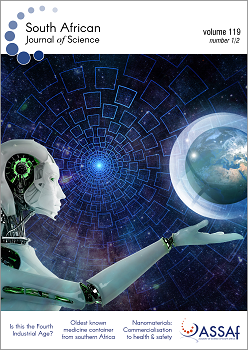Comparison of phosphorus-based extractants on manganese separation from citrate leach solutions for recycling of lithium-ion batteries
DOI:
https://doi.org/10.17159/sajs.2023/11399Keywords:
citric acid, metal citrate complexes, solvent extraction, hydrometallurgy, lithium-ion battery recyclingAbstract
The performance requirements of modern lithium-ion batteries (LIBs) necessitate the use of a number of scarce and strategically sensitive metals such as lithium and cobalt. Recycling end-of-life LIBs reduces the demand on the primary sources of these metals and helps reduce the environmental impact of LIB waste. Citric acid has proven to be an effective environmentally friendly and sustainable lixiviant; however, the formation of metal citrate complexes complicates subsequent metal separation processes such as solvent extraction. This study enhances the understanding of LIB metal separation from citric acid media by comparing the metal separation performance of phosphorus-based liquid-liquid extractants from a citric acid leach. The optimum Mn(II) extraction pH decreases as the extractant’s phosphorus oxidation state increases from phosphinic to phosphonic to phosphoric, due to the oxygen atoms that surround the central phosphorus atom. The maximum Mn(II) separation with Cyanex 272, PC-88A, and D2EHPA was observed at pHs of 6, 3, and 3, respectively. D2EHPA further provided the best separation of Mn(II) over Al, Co, Li, and Ni with separation factors of 137, 191, 118, and 601, respectively. No research is currently available on the metal separation performance of phosphonic (PC-88A) or phosphinic (Cyanex 272) organic extractants from citric acid media.
Significance:
- This study is the first to investigate the use of phosphonic and phosphinic extractants for metal separation from citric acid leach solutions, towards using citric acid as an environmentally friendly lixiviant.
- The phosphoric extractant, D2EHPA, enabled successful and sequential separation and extraction of aluminium, manganese and lithium, making the process technologically feasible and attractive.
Published
Issue
Section
License

All articles are published under a Creative Commons Attribution 4.0 International Licence
Copyright is retained by the authors. Readers are welcome to reproduce, share and adapt the content without permission provided the source is attributed.
Disclaimer: The publisher and editors accept no responsibility for statements made by the authors
How to Cite
- Abstract 536
- PDF 763
- EPUB 188
- XML 402












.png)